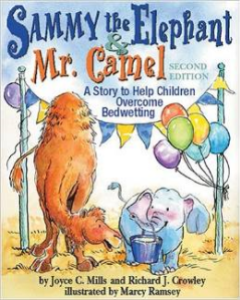
Bedwetting is fairly common in children. In fact, close to 1 in 10 children over 5 years of age experience frequent bedwetting, or enuresis, meaning having accidents more than 3 nights per week. Bedwetting has many causes, but the most common (according to the International Children’s Continence Society) are:
- Most bedwetting children are very difficult to arouse at night
- Many children have kidneys that produce too much urine at night
- The bladder may be smaller or contract too frequently in children who experience bedwetting
If your child is experiencing bedwetting frequently, and is over 5 years of age, there is help available! The first step is to talk with your pediatrician. Your doctor may refer your child to a specialist, or may treat the child herself. The doctor will evaluate your child for other medical problems which can be related to bedwetting, and may recommend using a common medication called Desmopressin which helps for children who are producing too much urine at night. If your child is having daytime accidents or constipation, it is important that these problems are addressed before the bedwetting. This is crucial as we find that often times, nighttime problems resolve once the daytime problems are addressed.
Many parents are shocked to learn that physical therapists like myself often help children with bedwetting problems—we do! Typically, we help with the following:
- Supporting you and your child build stellar bladder habits. Typically, parents and children are given diaries to fill out at the first visit so we can look at everything from fluid intake to volume of urination, frequency of urination, regularity of bowel movements, and other factors. This helps us make very specific recommendations for your child to improve habits which may be contributing to problems. Remember, if your child is having daytime accidents along with nighttime problems, we will always address the daytime problems first!
- Managing constipation or other bowel problems. Constipation is the worst—and often plays a huge role in bladder problems! We work with children to make sure they are “happy poopers”—teaching children how to sit properly on the toilet, improve dietary habits, and build a strong bowel routine.
- Making sure the pelvic floor muscles are working properly. Some children will have “dysfunctional voiding” or “paradoxical contractions” basically meaning their pelvic floor muscles are not relaxing when they should to help the child empty the bladder or bowels. We use external surface electrodes and animated biofeedback to help parents and children see a visual of the muscles and retrain the needed coordination for proper functioning. This is important to make sure the bladder is emptying the way it needs to during the day.
- Managing an alarm training program. After medication, alarms are actually one of the most recommended first-line treatments to improve bedwetting. There are some alarms that go on the bed itself, and others than clip inside the child’s pull-up or underwear. Typically, kids who regularly experience bedwetting are heavy sleepers, so the alarm helps to wake the child up to use the bathroom. Your physical therapist will help train your family how to use the alarm, and checks in with you regularly to make sure everything is going as it should.
- Daytime or nighttime bladder training. If the alarm doesn’t work, dry bed training can be used to help identify the time the accident is occurring and slowly train the bladder. This technique is designed specifically for the individual child based on diary information. For both this and alarm training, Moms and Dads play a big role in making this successful!
Do you have any questions about physical therapy for bedwetting? Colleagues, is there anything you would like to add about physical therapy for enuresis? Please let me know in the comments below!! If you live in the Atlanta area and your child is experiencing bedwetting, call my office today to set-up an appointment!
Here are a few great resources on bedwetting:
Educational Booklets from the International Children’s Continence Society (ICCS): There are so many great ones here on everything from constipation to bedwetting!
Practical consensus guidelines for the management of enuresis: A journal article published by the European Journal of Pediatrics in 2013, open access.
PottyMD.com: A great website that sells books, alarms, watches, etc. to help children with potty problems.
“Do you need to go potty?” 5 Tips to Improve your Kiddo’s Bathroom Health: Written by me J
4 Children’s Books to Improve your Child’s Bathroom Health: Written by me—a great one on bedwetting in there J
Have a great week!
Jessica







